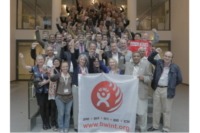NIOSH will celebrate a notable 20th anniversary this month. On October 19, 1996, a new facility was dedicated on NIOSH’s Morgantown, West Virginia, campus. The facility, often referred to now as the “L” Building, provided NIOSH for the first time with a strategic convergence of specialized equipment and dedicated laboratory space for advanced health-effects research. Organizationally, the responsibilities for those studies were delegated to a newly created Health Effects Laboratory Division (HELD). At the same time, the facility added vital work space and expanded research opportunities for the existing Morgantown divisions—the Division of Respiratory Disease Studies (now the Respiratory Health Division) and the Division of Safety Research.
The inauguration of new research in Morgantown was a landmark event for NIOSH in many ways. At the crossroads of the 20th and 21st centuries, the ability to conduct cutting-edge health-effects studies added immeasurably to our scientific repertoire. By expanding our knowledge about the complex processes through which illnesses occur and progress, it gave us significantly greater power to further reduce the toll of the legacy diseases associated with traditional occupations and industries. The nation had made great inroads since the 1970s, but continued success demanded increasingly sophisticated knowledge. At the same time, with those new capabilities, we could better predict the implications of the rapidly changing American economy for worker health in the new millennium.
The new facility gave us a competitive advantage, too, in recruiting talent to the occupational safety and health field. The promise of doing world-class research in a state-of-the-art working environment was a strong inducement for attracting innovative, highly trained men and women who might otherwise have sought careers in other health fields. The new facility brought over 200 new jobs into the Morgantown area, benefitting the local economy and strengthening our ties with West Virginia University and other respected research partners.
The dignitaries who participated in the 1996 dedication, notably the keynote speaker, the late Senator Robert C. Byrd, predicted a bright future for the L Building as a centerpiece for service to the nation’s heath. We at NIOSH are proud that those predictions have been realized many times over in the 20 years since. The facility dedicated in 1996 has been instrumental in generating new scientific knowledge across the wide spectrum of 21st-century occupational health and safety needs.
For example, with the strategic research space and advanced equipment that the facility affords, we have been able to continue progress at a robust pace against persistent ills of the workplace, such as asbestos-related diseases, coal workers’ pneumoconiosis, traumatic injury, and musculoskeletal disorders. At the same time, the research out of the L Building has contributed significantly to the past 20 years of national decision-making on emerging issues that were only beginning to gain visibility in the 1990s. Those issues include nanotechnology, emergency responder needs in disasters of natural and human origin, protection of the healthcare workforce against novel and pandemic diseases, and implications of greater workforce diversity for the correct fit of life-saving safety equipment.
In all of those areas of research, the nation has benefitted not only from the cutting-edge science practiced in the L Building, but also from the facility’s role in advancing collaboration and professional development. This is true whether we speak of external collaboration with private- and public-sector partners in initiatives such as the National Occupational Research Agenda, which also made its debut in 1996, or whether we refer to today’s new era of “virtual” teamwork across NIOSH’s geographically dispersed locations.
There are many other accomplishments, findings, and products that have resulted either directly or indirectly over the past 20 years from the construction of this facility. Please follow the NIOSH Science Blog to read more later this month.



